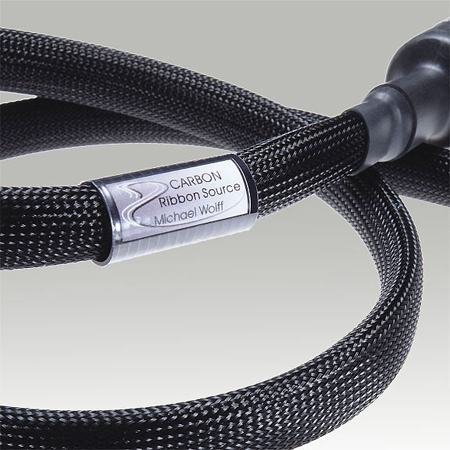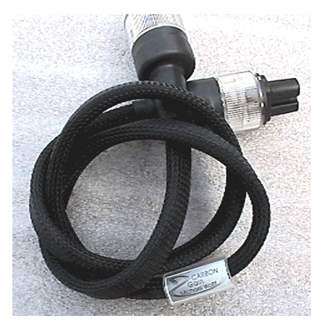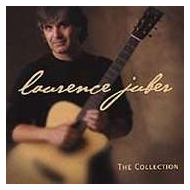You are reading the older HTML site
Positive Feedback ISSUE
14
july/august 2004
michael wolff
Carbon Ribbon Power Source AC cords
as reviewed by John Beavers

|
JOHN BEAVER'S SYSTEM
LOUDSPEAKERS
ELECTRONICS
SOURCES
CABLES
ACCESSORIES
|
Always on the lookout for interesting audio products, I came across the Michael Wolff Carbon Ribbon Source, a unique power cord that uses carbon in its construction. Internet research indicated that people who had heard this cord were experiencing broad improvements in the performance of their systems. This sparked my curiosity, and I decided to take Wolff up on his free thirty-day audition period. (I should mention that the free auditions are made available only to members of Audiogon.com who have good feedback ratings.)
Two days after I placed my order, I received my first power cord, designed for use with source components and preamps only. It looked to be very well made, with high quality connectors and craftsmanship. When I asked Michael about the construction of the cord, he graciously provided the following list:
-
Teflon thin wall dielectric to insulate bare conductors
-
Oxygen-free copper bare ribbon wire
-
Certified oxygen-free copper ribbon solid wire
-
High-purity silver bare round wire
-
.075-inch carbon ribbon (light density)
-
.050-inch carbon ribbon (light density)
-
.050-inch carbon ribbon (medium density)
-
1.5-inch (3-to-1) shrink tube
-
.5-inch (2-to-1) shrink tube
-
.75-inch Techflex outer sleeve (according to Wolff, the best that money can buy)
-
.75-inch cut carbon tube for ID collar
-
Furutech rhodium connectors for Source cord
-
Furutech gold connectors for Gain cord
-
15-to-1 Teflon heat shrink to go over the ID tube
While this looked like a top-of-the-line parts list, I'm neither an electrical engineer nor a power cord designer, so I couldn't be certain that my audio system was going to get a kick in the pants. Power cords had already made major improvements in my system, so I doubted that the Wolff cords could raise the bar further. I compared the Carbon Ribbon Power Cord to my Sahuaro Prethrilla and Ampthrilla cords, along with the Vans Evers Model 222 and a custom version of the Pandora.

Up first was a comparison with the Vans Evers Model 222 power cord on my Audiomeca Mephisto II.X CD player. I had replaced that cord with the Sahuaro Prethrilla last year. Putting it back in, I again found that it was highly musical and slightly warm. After getting reacquainted with the Vans Evers cord, I switched to the Michael Wolff Carbon Ribbon Source. On Norah Jones' Come Away with Me, the first disc I tried, I was struck by the crisp, life-like instruments and vocals. The sound was very neutral, compared to the Vans Evers cord's warmer presentation. The soundstage took on a tangible presence. Placed in clearly outlined locations within a wide stage, the instruments had more impact and accuracy, as if I was seeing them on a painter's canvas. Cymbals, which had a natural ring, exhibited the most easily detectable improvement. Images which had been fairly one-dimensional, took on holographic depth. I was very impressed. This was not just tonal control—it was like a component upgrade, in which the very character of my system had changed. The one downside was that dynamics sounded compressed at lower volumes. To solve this problem, I simply turned up the volume, but sometimes I do like to listen at low volumes.
 The following day, with Laurence Juber's The
Collection in the player, I again listened to one, then the other power
cord. Switching to the Vans Evers cord from the Wolff Source cord was
sobering. The presentation became muddy and recessed. I hadn't realized how
much effect a power cord could have until the Source cord provided a
reference. At this point, I was even more curious about the whys and
wherefores of what I was hearing. Michael Wolff provided some additional
feedback:
The following day, with Laurence Juber's The
Collection in the player, I again listened to one, then the other power
cord. Switching to the Vans Evers cord from the Wolff Source cord was
sobering. The presentation became muddy and recessed. I hadn't realized how
much effect a power cord could have until the Source cord provided a
reference. At this point, I was even more curious about the whys and
wherefores of what I was hearing. Michael Wolff provided some additional
feedback:
"One of the major objectives and goals of using carbon in the power cord was the elimination and shielding of RFI. RFI does not increase the high end. What it does is put that nice little edge on the music, which you just happen to hear more of in the highs. Commonly referred to as listener fatigue, edginess, etc., this is why a lot of power conditioners and cords roll off the highs. The manufacturers have to eliminate the effects of RFI. Simple shielding, pellets, stardust, etc., do not eliminate the RFI, but instead roll off the highs to make it sound like things are better. I take great pride in the principal behind my cord, in the fact that it does actually attack the presence of the RFI signal. The cable does not have to be tuned or rolled off…. In power cords with metal shielding on the outside sheath of the wire runs, RFI is reflected off, it won't enter the cable, BUT what about RFI that is already present? Think carbon, think absorption rather than reflection."
The next night, I compared the Wolff Source with a stock cord using Patricia Barber's Verse. With the Carbon Ribbon cord, I heard stunning realism. Cymbals had a solid ring, and horns had clean, brassy detail. Her vocal presence was very nice, with excellent transparency. Bass was hard-hitting and tight, the soundstage was wide and deep, and everything was imbued with life-like vibrancy. How much of this was due to the carbon cord? In went a better-than-average stock cord. Oh my! The realism was severely diminished, and the music sounded noticeably "recorded." The presentation was flat, and there was a noticeable loss of transparency. Cymbals were reduced to a sputtering and clicking sound. I no longer heard the tonal qualities that had so impressed me with the carbon cord. Brush strokes on drums and cymbal hits were thin and artificial. Barber's vocal presence was okay, but it didn't have the fullness that I had heard with the Wolff cord. The horns were screechy and grating on the ears—far from natural. The bass was still hard-hitting, but it was mushier and less tight. It appeared that the carbon cord was responsible for the improvements I had heard.
Next up, the Gold Medal round, the Carbon Ribbon
Source Power Cord vs. the Sahuaro Prethrilla Power Cord, on Joe Satriani's
Strange Beautiful Music SACD. The
Carbon cord was up first, and I experienced the same qualities that I'd
heard in my previous sessions. I really liked the sound of the electric
guitar. It seemed to have more energy, as if it had been hooked up to a more
powerful amplifier. Then it was time to switch to the Sahuaro cord, and my
last chance to save my wallet. It didn't take long to hear the reduction in
sound quality. The electric guitar, which had been right on the money, with
a large, fiery center-stage presence, dropped down to a lower level in the
soundstage. There was a reduction in definition, and in that hard-to-define
quality called musicality, which had been so apparent with the Wolff cord.
The drums, which had sounded deep and richly dynamic, now sounded muddier
and had less impact. The layout of instruments within the soundstage, which
had been laser sharp, became less focused, more of a wall of sound than the
layered, precise panorama I'd heard with the Carbon cord. I switched between
the two cords for the next two hours, playing various types of music, and my
initial impressions were confirmed. Though I had anticipated that the
contest would be close, the Carbon cord surpassed the Sahuaro cord. It was
time to write Michael a check.
if it had been hooked up to a more
powerful amplifier. Then it was time to switch to the Sahuaro cord, and my
last chance to save my wallet. It didn't take long to hear the reduction in
sound quality. The electric guitar, which had been right on the money, with
a large, fiery center-stage presence, dropped down to a lower level in the
soundstage. There was a reduction in definition, and in that hard-to-define
quality called musicality, which had been so apparent with the Wolff cord.
The drums, which had sounded deep and richly dynamic, now sounded muddier
and had less impact. The layout of instruments within the soundstage, which
had been laser sharp, became less focused, more of a wall of sound than the
layered, precise panorama I'd heard with the Carbon cord. I switched between
the two cords for the next two hours, playing various types of music, and my
initial impressions were confirmed. Though I had anticipated that the
contest would be close, the Carbon cord surpassed the Sahuaro cord. It was
time to write Michael a check.
After spending many evenings enjoying the exciting sound delivered by the Source power cord, I received a call from Michael informing me that a new version was on its way to me. It seemed that he had been busy perfecting his design, and in the new cord, flat copper wire replaced the stranded copper in the original cord. When I asked what the sonic differences would be, and what caused them, he explained that he wasn't entirely sure. Perhaps the interaction between the Carbon Ribbon conductor's geometry and the OFC copper geometry, which were now the same shape, might be the reason he was hearing stronger dynamics, better rhythm and pace, and an increase in detail. His next statement really whet my appetite for the new cord: "It seems as though it is easier to listen to music being performed with an entire group of instruments, and how they are interacting with each other, not only in melody but dynamically."
The new Source cord arrived the following day. The improvements Michael spoke of were immediately and readily apparent. Not only did I hear an increase in dynamics and detail, but the volume level required to hear these improvements was lessened, which was most welcome. I also received Michael's Gain cord, which is designed for use with amplifiers, but decided not to hook it up until I had a firmer grasp on what the new Source cord was bringing to the table.
After a week, I had no doubt about which Source cord I wanted to keep. The latest version had raised the bar another notch. I then decided that it was time to hook up the Gain cord. With this cord on my amplifier, I heard a further refinement of the sonic characteristics that had been introduced by the Source cord. Having raved about these cords to friends, and being received with a fair amount of skepticism, I was excited about taking them along on a visit to a friend who has been my audiophile mentor for many years. I trust his listening skills and audio knowledge more than just about anyone else I know, so this would be the acid test for the power cords.
My friend confirmed much of what I heard, though he was more critical in some areas. He said, "They seem to liven up the high frequencies, but I'm not sure this is such a good thing. They added some harshness to the vocals in several selections, and some hiss to several cymbal crashes. Perhaps the cords just reveal more detail, perhaps they enhance certain frequencies. Either way, I could overlook those few instances to get the cohesiveness the cords provided. The positive results far outweigh the few negatives."
It turns out that Michael had received much the same feedback from another customer, and was already working on a refinement of the cord. A month later, I received yet another version. This cord kept all the qualities of the previous one, but it had more smoothness and a more even frequency balance. One change that stood out for me was that the compression of dynamics at low volume was significantly reduced, and the other was the smoothing of the midrange, which resulted in beautifully fleshed-out vocals. The new version of the Source cord is provided as a free upgrade to owners of previous versions. For a manufacturer to work this closely with his customers, taking feedback, making design changes, and providing the latest model to his customers at no charge, is a measure of exemplary service.
Michael Wolff's interest in power cords began four years ago, when he noticed positive improvements brought about by his use of an aftermarket cord. About two years ago, he made a cord of his own, one that he felt sounded pretty good. He ran an ad on Audiogon entitled "Another Damn Power Cord." The phrase was so catchy that he actually sold some, and customers liked it. After about a year, he got into some heavy R&D, using the knowledge of graphite composite materials that he had acquired working for an aerospace company. The first carbon ribbon cord he built had great potential, and he continues to refine it.
I asked Michael what it was like to try to get a toehold in the audio marketplace as a first-time entrepreneur. I liked his response: "It's like the market is a huge limestone pit. You show up for your first day and you see all the other manufacturers down in the pit with their huge earthmovers and shovels. Then the foreman, whose name is 'Free Enterprise,' hands you an ice pick." Michael has done some incredible work with that ice pick. Without his cords on my components, I lose my reference-quality sound. The Carbon Ribbon Source and Gain cords have my highest recommendation. John Beavers
Carbon Ribbon Source Power cord
Retail:
$750 per 6 foot
Michael Wolff
web address:
http://wolffcords.home.comcast.net
